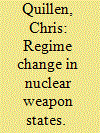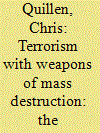| Srl | Item |
| 1 |
ID:
022726


|
|
|
|
|
| Publication |
2002.
|
| Description |
279-292
|
|
|
|
|
|
|
|
|
|
|
|
|
|
|
|
| 2 |
ID:
147600


|
|
|
|
|
| Summary/Abstract |
This article examines the growing chemical weapon capabilities of the Islamic State from the crude poisons and toxins of its founding father Abu Mus'ab al-Zarqawi to the current battlefield use of indigenously produced mustard gas in Iraq and Syria. By examining this evolution as a phenomenon separate from Al Qaeda, a clearer picture emerges of a dedicated and increasingly successful chemical weapons program that threatens military forces and civilian populations around the world.
|
|
|
|
|
|
|
|
|
|
|
|
|
|
|
|
| 3 |
ID:
150083


|
|
|
|
|
| Summary/Abstract |
The threat of losing control of nuclear weapons during political crises is not sufficiently prepared for by either individual nuclear powers or the international community. The relative success of securing the Soviet nuclear arsenal after the collapse of the USSR has lulled the world into a false sense of security, but the threat is real and may be increasing. Drawing upon historical case studies in which the government of a nuclear weapon state failed, the author recommends policy options for future scenarios in the hope of preventing potential nuclear disasters in newly proliferating states such as North Korea and Iran.
|
|
|
|
|
|
|
|
|
|
|
|
|
|
|
|
| 4 |
ID:
020220


|
|
|
|
|
| Publication |
2001.
|
| Description |
47-65
|
|
|
|
|
|
|
|
|
|
|
|
|
|
|
|
| 5 |
ID:
154320


|
|
|
|
|
| Summary/Abstract |
The reasons for the use of chemical weapons remain an understudied concept in international relations despite their continual use in conflicts. By comparing chemical weapon use by the regimes of four Arab states — Egypt, Iraq, Libya, and Syria — over the last 50 years, this article seeks to discern the scenarios in which chemical weapons use is likely, and it offers policies to dissuade or, at least, mitigate their use.
|
|
|
|
|
|
|
|
|
|
|
|
|
|
|
|